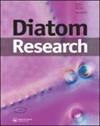用硅藻环境序列填充参考库:优点和缺点
IF 1.3
3区 生物学
Q2 MARINE & FRESHWATER BIOLOGY
引用次数: 0
摘要
应用DNA元条形码技术鉴定硅藻种类是一种经济、快速、可靠的替代光镜鉴定的方法。利用rbcL基因的短DNA序列和' Diat。barcode’是一个参考条形码库,可以识别法国河流中90%以上的环境序列。但在其他地区,如法国热带海外部,该图书馆的完整性要低得多。采用高通量测序数据结合自然样品显微计数数据的条形码库补全方法(Rimet等)。Citation2018)在马提尼克岛和瓜德罗普岛(西印度群岛)的河流中进行了应用和测试,其中只有45%的环境序列可以使用Diat识别到物种水平。条形码v9。本文还以Ulnaria goulardii和Nupela和Epithemia两种新种为例,说明了该方法对岛上最丰富的物种进行了条形码定位。形态相似的物种的情况更为复杂,可以通过参考Gomphonema designatum和G. bourbonense来说明。利用分子和形态数据的结合,他们的同一性,作为波旁蛇,被证明与他们的参考条形码。然而,当几个形态相似的物种和几个属于同一进化支的环境序列存在时,不可能将条形码与相应的形态物种联系起来。应用这种方法启用了Diat。将更新条形码库(v.10),其中来自西印度群岛的84%的环境序列现在可以在物种水平上识别。然而,许多形态物种仍然缺乏条形码。在这些情况下,必须采用更经典的方法,如细胞分离、桑格测序和培养物的形态学观察。本文章由计算机程序翻译,如有差异,请以英文原文为准。
Filling reference libraries with diatom environmental sequences: strengths and weaknesses
Diatom species identification with DNA metabarcoding is an economical, fast and reliable alternative to identification via light microscopy for river quality monitoring. Using a short DNA sequence of the rbcL gene and ‘Diat.barcode’, a reference barcode library, enables the identification of more than 90% of the environmental sequences to species level in French rivers. But the completeness of this library is much lower in other regions, such as the tropical French overseas departments. A barcode library completion method using high-throughput sequencing data combined with microscopy count data from natural samples (Rimet et al. Citation2018) was applied and tested in rivers of Martinique and Guadeloupe (West Indies), for which only 45% of the environmental sequences could be identified to species level using Diat.barcode v9. Assigning barcodes to the most abundant species in the islands by this method is illustrated with Ulnaria goulardii and two new species belonging to Nupela and Epithemia, which are also described in this paper. The more complex situation of morphologically similar species is illustrated by reference to Gomphonema designatum and G. bourbonense. Using a combination of molecular and morphological data, their conspecificity, as G. bourbonense, is demonstrated with their reference barcodes. However, when several morphologically similar species and several environmental sequences belonging to the same clade are present, it is not possible to relate the barcodes to corresponding morphological species.Applying this method enabled the Diat.barcode library (v.10) to be updated, with 84% of the environmental sequences from the West Indies now identifiable at the species level. However, many morphological species still lack barcodes. In these cases, more classical methods, such as cell isolation, Sanger sequencing and morphological observations of cultures, must be applied.
求助全文
通过发布文献求助,成功后即可免费获取论文全文。
去求助
来源期刊

Diatom Research
生物-海洋与淡水生物学
CiteScore
2.70
自引率
16.70%
发文量
27
审稿时长
>12 weeks
期刊介绍:
Diatom Research is the journal of the International Society for Diatom Research. The journal is published quarterly, in March, June, September and December, and welcomes manuscripts on any aspect of diatom biology.
In addition to full-length papers, short notes and reviews of recent literature are published which need not contain all the sections required for full-length papers; we see these as being necessary to record information which is of interest but which cannot be followed up in detail. Discursive “Opinion” papers are encouraged which would not necessarily follow the normal lay-out. If extremely long papers are to be offered, the author(s) should contact the editors first to discuss any problems. Book reviews, obituaries and meeting reports can be published. All papers will be subject to critical review by the editors and referees, as appropriate to their content. Papers will be accepted in English only.
 求助内容:
求助内容: 应助结果提醒方式:
应助结果提醒方式:


